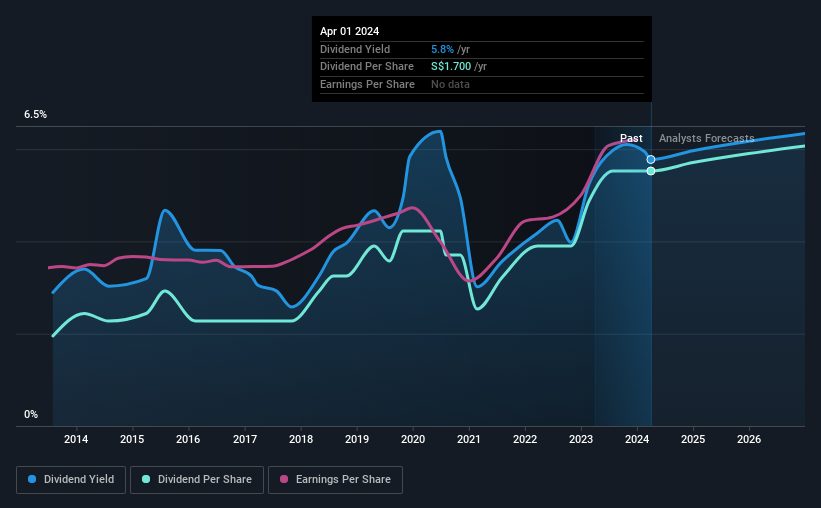United Overseas Bank (SGX:U11) Will Pay A Dividend Of SGD0.85
The board of United Overseas Bank Limited (SGX:U11) has announced that it will pay a dividend of SGD0.85 per share on the 9th of May. This makes the dividend yield 5.8%, which is above the industry average.
View our latest analysis for United Overseas Bank
United Overseas Bank's Earnings Will Easily Cover The Distributions
If the payments aren't sustainable, a high yield for a few years won't matter that much.
United Overseas Bank has a long history of paying out dividends, with its current track record at a minimum of 10 years. Taking data from its last earnings report, calculating for the company's payout ratio shows 51%, which means that United Overseas Bank would be able to pay its last dividend without pressure on the balance sheet.
Over the next 3 years, EPS is forecast to expand by 10.3%. Analysts forecast the future payout ratio could be 50% over the same time horizon, which is a number we think the company can maintain.
Dividend Volatility
The company has a long dividend track record, but it doesn't look great with cuts in the past. Since 2014, the dividend has gone from SGD0.60 total annually to SGD1.70. This means that it has been growing its distributions at 11% per annum over that time. United Overseas Bank has grown distributions at a rapid rate despite cutting the dividend at least once in the past. Companies that cut once often cut again, so we would be cautious about buying this stock solely for the dividend income.
United Overseas Bank Could Grow Its Dividend
Given that the dividend has been cut in the past, we need to check if earnings are growing and if that might lead to stronger dividends in the future. It's encouraging to see that United Overseas Bank has been growing its earnings per share at 7.8% a year over the past five years. Earnings are on the uptrend, and it is only paying a small portion of those earnings to shareholders.
Our Thoughts On United Overseas Bank's Dividend
In summary, it's great to see that the company can raise the dividend and keep it in a sustainable range. While the payout ratios are a good sign, we are less enthusiastic about the company's dividend record. The payment isn't stellar, but it could make a decent addition to a dividend portfolio.
It's important to note that companies having a consistent dividend policy will generate greater investor confidence than those having an erratic one. However, there are other things to consider for investors when analysing stock performance. Taking the debate a bit further, we've identified 1 warning sign for United Overseas Bank that investors need to be conscious of moving forward. If you are a dividend investor, you might also want to look at our curated list of high yield dividend stocks.
Have feedback on this article? Concerned about the content? Get in touch with us directly. Alternatively, email editorial-team (at) simplywallst.com.
This article by Simply Wall St is general in nature. We provide commentary based on historical data and analyst forecasts only using an unbiased methodology and our articles are not intended to be financial advice. It does not constitute a recommendation to buy or sell any stock, and does not take account of your objectives, or your financial situation. We aim to bring you long-term focused analysis driven by fundamental data. Note that our analysis may not factor in the latest price-sensitive company announcements or qualitative material. Simply Wall St has no position in any stocks mentioned.

 Yahoo Finance
Yahoo Finance 
